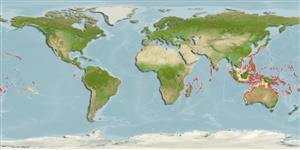Classification / Names
Common names from other countries
Main reference
Size / Weight / Age
Max length : 3.0 cm SL male/unsexed; (Ref. 48637)
Environment
Marine; reef-associated; depth range 2 - 45 m (Ref. 90102), usually 2 - 15 m (Ref. 27115)
Climate / Range
Tropical; 23°C - 27°C (Ref. 27115), preferred ?
Distribution
Indo-Pacific: Red Sea to the Marquesan Islands (Ref. 2334); including Japan, Taiwan, the Philippines, Malaysia and Indonesia.
Countries | FAO areas | Ecosystems | Occurrences | Introductions
Short description
Dorsal
spines
(total): 5 - 6;
Dorsal
soft rays
(total): 7-8;
Anal
spines: 1;
Anal
soft rays: 8. Characterized by head white with brown spots; dorsal half on the body white with narrow orange stripes; orange caudal fins with three large brown spots on second dorsal and upper part of caudal fin; orange pectoral fin with white central portion; greatly prolonged first two dorsal spines; pectoral rays with filamentous tips; united pelvic fins forming disc, reaching to origin of anal fin; pointed caudal fin; longitudinal scale series 22-25; ctenoid scales anteriorly, ctenoid posteriorly; cheeks and operculum without scales; top of head with large scales; depth of body 5.3 in SL (Ref. 90102).
IUCN Red List Status (Ref. 115185)
Threat to humans
Harmless
Human uses
Aquarium: commercial
More information
Common namesSynonymsMetabolismPredatorsEcotoxicologyReproductionMaturitySpawningFecundityEggsEgg development
ReferencesAquacultureAquaculture profileStrainsGeneticsAllele frequenciesHeritabilityDiseasesProcessingMass conversion
Tools
Special reports
Download XML
Internet sources
Estimates of some properties based on models
Phylogenetic diversity index
PD50 = 0.7500 many relatives (e.g. carps) 0.5 - 2.0 few relatives (e.g. lungfishes)
Trophic Level
3.1 ±0.3 se; Based on size and trophs of closest relatives
Resilience
High, minimum population doubling time less than 15 months (Preliminary K or Fecundity.)
Vulnerability
Low vulnerability (10 of 100)
Price category
